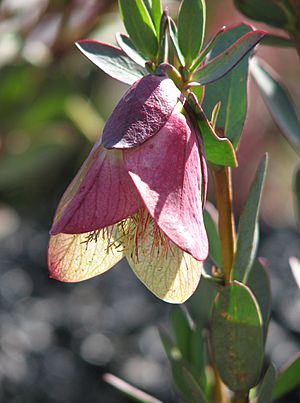Qualup bell facts for kids
Quick facts for kids Qualup bell |
|
|---|---|
 |
|
| Pimelea physodes growing in the Royal Botanic Gardens, Cranbourne | |
| Scientific classification | |
| Genus: |
Pimelea
|
| Species: |
physodes
|
| Synonyms | |
|
|
The Qualup bell (scientific name: Pimelea physodes) is a special type of shrub. It grows only in Western Australia, which means it's endemic there. This plant is famous for its unique bell-shaped flowers. These flowers are tiny and greenish, but they are surrounded by long, colorful leaf-like parts called bracts. These bracts can be red, purple, green, and cream, making the flower look like a beautiful bell!
Contents
What Does the Qualup Bell Look Like?
The Qualup bell is a shrub that usually grows to be about 0.2 to 1 meter (about 8 inches to 3 feet) tall. It has one main stem that starts from the ground.
Leaves and Flowers
Its leaves grow in pairs, one across from the other. They are mostly attached directly to the stem without a stalk, which is called sessile. The leaves are shaped like an egg or a narrow oval. They are about 12 to 32 millimeters (0.5 to 1.3 inches) long and 5 to 11 millimeters (0.2 to 0.4 inches) wide. Both sides of the leaves are the same shade of green.
The flowers grow in a bell-like shape. They look a bit like the flowers of some other plants called darwinia bells, even though they are not closely related. The stalk that holds the group of flowers, called a peduncle, is about 3 to 14 millimeters long.
Each tiny flower is green or creamy green. It has a cup-shaped base called a floral cup, which is about 6 to 9 millimeters long. The outer parts of the flower, called sepals, are very narrow and triangular, about the same length as the floral cup.
Most of the Qualup bell flowers have both male and female parts (bisexual). However, some flowers are only female. Like other Pimelea plants, the Qualup bell does not have petals. The male parts, called stamens, are about 11 to 16 millimeters long. The female part, called the style, is reddish and sticks out from the flower.
Colorful Bracts
Each group of flowers is surrounded by three or four pairs of special leaf-like structures called involucral bracts. These bracts are green and cream-colored, and often have splashes of red or purple. They are oval-shaped, about 22 to 60 millimeters (0.9 to 2.4 inches) long and 11 to 45 millimeters (0.4 to 1.8 inches) wide. They are also glabrous, meaning they are smooth and hairless.
The Qualup bell usually flowers between July and October.
Where Does the Qualup Bell Grow?
The Qualup bell grows in sandy areas and on hillsides. You can find it in the coastal region of Western Australia. This area stretches between the Pallarup Nature Reserve, Fitzgerald River National Park, Jarramungup, and Mount Desmond near Ravensthorpe.
Who Helps Pollinate It?
Scientists believe that a bird called the tawny-crowned honeyeater (Gliciphila meanops) helps to pollinate the Qualup bell. Pollination is when pollen is moved from one flower to another, helping the plant make seeds.
Is the Qualup Bell Protected?
The Western Australian Government's Department of Parks and Wildlife has classified the Qualup bell as "not threatened." This means it is not currently at risk of disappearing.

